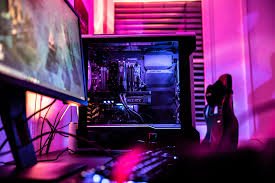Your gaming PC was once a powerhouse, crushing every title at maximum settings. Now it struggles with newer games, and you’re wondering if it’s time for an upgrade. Understanding when your system needs new hardware can save you from frustration and help you maintain peak gaming performance.
Gaming technology evolves rapidly, and what seemed future-proof just two years ago might now be the weak link in your setup. Smart upgrades can breathe new life into your system, but knowing which components to prioritize makes all the difference. Let’s explore the telltale signs that your gaming PC is ready for its next evolution.
Frame Rates Dropping Below Expectations
Modern games demand more processing power than ever before, and declining frame rates are often the first warning sign. If you’re consistently dropping below 60 FPS in games you used to run smoothly, your hardware is struggling to keep up. This performance drop usually indicates that your GPU or CPU can’t handle current gaming demands.
Frame rate inconsistency is equally problematic, causing stuttering and choppy gameplay that ruins immersion. When your system can’t maintain stable performance during intense gaming sessions, it’s time to investigate which component is causing the bottleneck. Using a bottleneck pc calculator can help identify whether your CPU or GPU is the limiting factor.
Temperature monitoring during gaming sessions reveals crucial information about your system’s health. If your components are thermal throttling due to excessive heat, performance will suffer dramatically regardless of their theoretical capabilities.
System Running Hotter Than Normal
High CPU utilization and temperature often go hand-in-hand with performance bottlenecks, creating a cycle of degraded performance. When components work harder to compensate for inadequate hardware, they generate more heat and consume more power. This increased thermal load can damage your system over time if left unchecked.
Understanding how long does bottlenecking run your system hot is crucial for protecting your investment. Prolonged high temperatures from bottlenecking can reduce component lifespan and trigger thermal throttling, further degrading performance. Keeping your system cool is essential not just for avoiding thermal throttling but also for extending the lifespan of your components.
Modern gaming PCs should maintain reasonable temperatures even under heavy loads. If your CPU consistently runs above 80°C or your GPU exceeds 85°C during gaming, your cooling solution may be inadequate for your current hardware setup.
Loading Times Becoming Unbearable
Storage bottlenecks manifest as painfully long loading screens and sluggish file transfers. If games take several minutes to load levels that used to load in seconds, your storage solution is likely outdated. Traditional hard drives struggle with modern game engines that expect fast data access for seamless gameplay.
Asset streaming in open-world games particularly stresses slower storage solutions, causing texture pop-in and stuttering. When your storage can’t keep up with data demands, even powerful CPUs and GPUs must wait for information. This creates a cascade effect that impacts overall system responsiveness.
SSD technology has become essential for modern gaming, with NVMe drives offering the fastest data access speeds. Upgrading from mechanical storage to solid-state drives provides one of the most noticeable performance improvements you can make.
CPU Usage Constantly Maxed Out
When your CPU consistently runs at 100% utilization during gaming, it’s become the bottleneck limiting your system’s potential. A bottleneck rechner analysis can confirm if your processor is holding back your graphics card’s performance. This scenario is particularly common when pairing older quad-core processors with modern high-end GPUs.
Background applications competing for CPU resources compound this problem, as insufficient processing power affects everything from game performance to basic multitasking. Modern games increasingly leverage multiple CPU cores, making older processors with fewer cores particularly vulnerable to bottlenecking.
CPU bottlenecks don’t just affect gaming performance; they impact streaming capabilities, content creation, and general system responsiveness. When your processor can’t handle current software demands, every computing task becomes slower and less efficient.
Graphics Settings Stuck on Low
If you’re forced to run games on low settings to achieve playable frame rates, your graphics card has become outdated. Modern GPUs should handle current-generation games at high settings while maintaining smooth performance. When you can’t enjoy visual improvements in newer titles, your GPU upgrade is overdue.
Ray tracing and DLSS technologies in modern games require significant graphics processing power. Older cards lacking these features miss out on visual enhancements that define current-generation gaming experiences. These technologies aren’t just nice-to-have features; they’re becoming standard expectations.
Resolution scaling becomes necessary when your GPU can’t handle native display resolutions. If you’re dropping from 1440p to 1080p or using aggressive upscaling to maintain performance, your graphics card needs upgrading.
Memory Limitations Causing Issues
RAM shortages manifest as system stuttering, slow application switching, and excessive hard drive activity. Modern games routinely use 8-16GB of system memory, making 8GB configurations increasingly inadequate. When your system relies heavily on virtual memory, performance degrades significantly.
Memory speed also impacts gaming performance, particularly with modern CPUs and GPUs. DDR4-2400 memory can bottleneck systems that would benefit from DDR4-3200 or faster speeds. Upgrading both capacity and speed often provides noticeable improvements in gaming smoothness.
Background applications and browser tabs compete with games for available memory. When your system runs out of physical RAM, it must use slower storage as virtual memory, creating performance bottlenecks that affect the entire system.
Using Bottleneck Analysis Tools
Professional bottleneck pc calculator tools help identify which components limit your system’s performance. These analyzers compare your CPU and GPU specifications to determine potential mismatches in processing power. Understanding bottleneck percentages guides upgrade decisions and budget allocation.
Online bottleneck calculators provide estimates, but real-world testing with monitoring software reveals actual performance limitations. Tools like MSI Afterburner, HWiNFO64, and Task Manager show live component utilization during gaming sessions. This data identifies which components consistently max out during demanding tasks.
Systematic testing with different graphics settings helps isolate bottlenecks. If lowering graphics quality doesn’t improve frame rates, your CPU is likely the limiting factor. Conversely, if reducing resolution significantly improves performance, your GPU needs upgrading.
Planning Your Upgrade Path
Smart upgrading starts with identifying the most limiting component in your system. CPU and GPU bottlenecks require different solutions, and addressing the wrong component wastes money while leaving performance issues unresolved. Motherboard and power supply compatibility must also be considered before purchasing new hardware.
Budget allocation should prioritize the component causing the most significant performance limitation. Sometimes a GPU upgrade provides the best value, while other systems benefit more from CPU or memory improvements. Understanding your specific bottleneck guides effective spending decisions.
Future-proofing considerations help ensure upgrades remain relevant for several years. Choosing components with headroom for future games and software updates provides better long-term value than minimal upgrades that quickly become outdated.
Conclusion: Timing Your Hardware Refresh
Recognizing when your gaming PC needs new hardware prevents frustration and maintains optimal gaming experiences. Performance monitoring tools and bottleneck analysis provide objective data about your system’s limitations. Don’t wait until your hardware fails; proactive upgrades ensure uninterrupted gaming enjoyment.
The sweet spot for upgrades typically occurs every 3-4 years, though individual components may need attention sooner. Graphics cards often require more frequent updates due to rapid advancement in visual technologies and gaming demands. CPU upgrades can often wait longer unless bottlenecking becomes severe.
Your gaming experience shouldn’t be compromised by outdated hardware when solutions are readily available. Strategic upgrades based on actual performance data ensure you get maximum value from your investment while maintaining the high-quality gaming experience you deserve.




